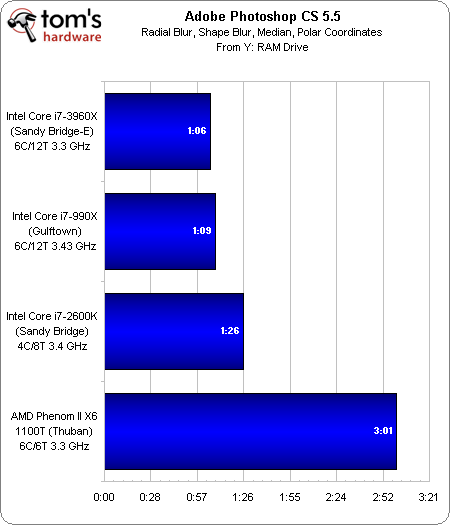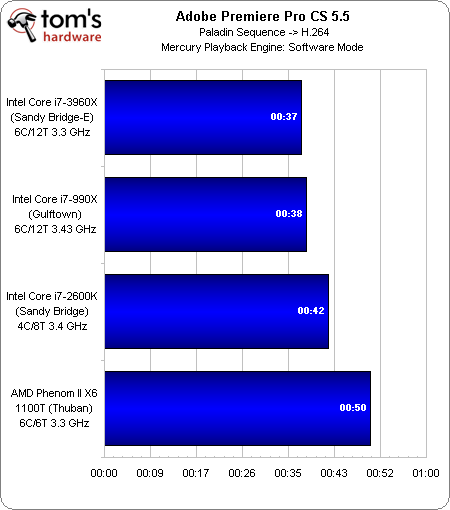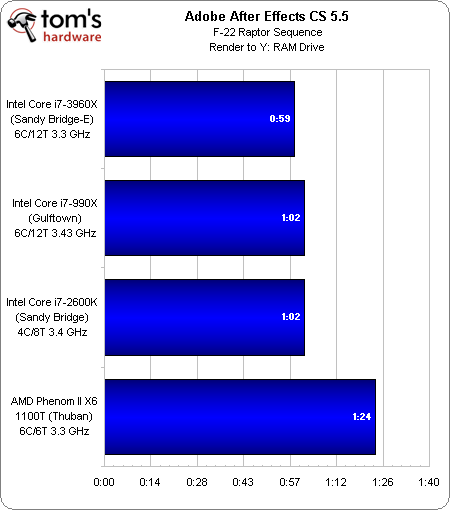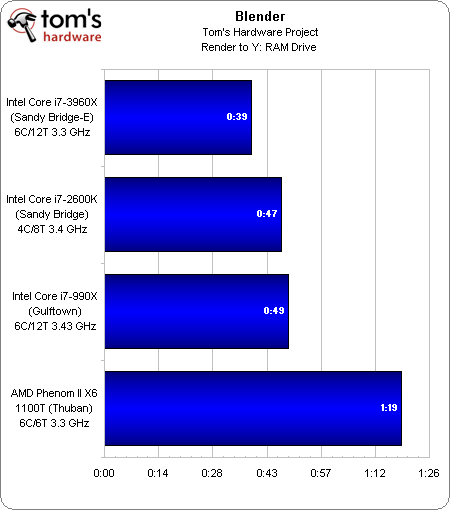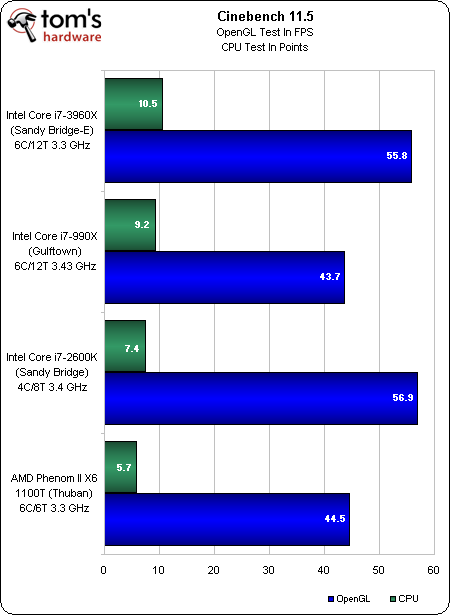Intel Core i7-3960X (Sandy Bridge-E) And X79 Platform Preview
It's always interesting to get hands-on time with unreleased hardware. We were recently able to benchmark Intel's upcoming Core i7-3960X CPU, comparing it to Core i7-990X, Core i7-2600K, and AMD's Phenom II X6. Will you be in line for Sandy Bridge-E?
Benchmark Results: Content Creation
Our threaded filter test favors the Core i7-990X over Intel’s Core i7-2600K. But when you fold in Sandy Bridge’s IPC advantages to a six-core architecture, the result is even better (if only by three seconds, in this case).
Normally this benchmark would be a drawn-out workstation-class test capable of making clear the benefits of one processor over another. However, Adobe is slowly extending hardware support for its Mercury Playback Engine to more Nvidia graphics cards.
As a result, our GeForce GTX 580 kicks in, cutting what used to be a 15-minute benchmark on Intel’s Core i7-990X down to 38 seconds. CPUs still influence the overall result, though, and the field finishes just as we’d expect.
The only real loser in After Effects is AMD’s Phenom II X6, which lags behind the rest of the closely-grouped field.
Architectural improvements help Sandy Bridge keep up with Gulftown in our Blender test. Sandy Bridge-E combines the best aspects of both to deliver a new top score.
Core i7-3960X walks away with the highest Cinebench CPU score. That much was expected.
It’s interesting, though, that Sandy Bridge and Sandy Bridge-E both facilitate better OpenGL-based rendering than Core i7-990X, particularly because Maxon specifically aims to isolate graphics card performance in this part of the metric:
Get Tom's Hardware's best news and in-depth reviews, straight to your inbox.
“The graphics benchmark in Cinebench is designed to minimize the influence of other system components. All geometry, shaders, and textures are stored on the graphics card prior to measurement, and no code is loaded during the measurement process. This minimizes the system influence, but unfortunately cannot eliminate it entirely.”
Current page: Benchmark Results: Content Creation
Prev Page Benchmark Results: Sandra 2011 Next Page Benchmark Results: Productivity-
tri force "AMD FX-8150 (Zambezi) 3.6 G...Alright, that's just mean"Reply
I felt really happy for a second :( -
for the price, the 8150 at 250 dollars will smoke intel out the water. IF you really want to go dolla per dollar , a dual socket amd opteron 6220 system will severely outperform the intel i73960 for alot cheaper. Thats 16 x 3.5 ghz turbo bulldozer cores against 6 3.3 ghz sandy bridge cores. hmmReply
-
jprahman I was really looking forward to Sandy Bridge-E, but it looks like a mixed bag from the review. The lack of USB 3 and especially PCI-E 3 was really disappointing, especially for an enthusiast class processor and chipset. The dearth of SATA ports was pretty surprising too, everything up to this review had indicated far more.Reply
The extra performance you can get looks pretty nice for stuff like transcoding, but the performance in the majority of applications doesn't justify the extra cost for the i7-3960. I'd rather get a i7-2600K or i5-2500K... or wait for Bulldozer to see how it performs relative to an i5-2500k or i7-2600k.
To be honest, this review almost comes off like an attempt to chill any interest high-end enthusiasts might have for Bulldozer. -
hmp_goose I predict a "meh" from enthusiast … And a far number of LGA1366 drivers looking for a price cut. ;-)Reply -
Wamphryi I just got an i7 2600 K and like a previous writer commented I have no regrets either. The 2600 K is such good bang for buck and lots of people seem to be snapping them up.Reply -
Tamz_msc I hope Bulldozer is more interesting than this. I honestly dont see many enthusiasts investing in this - they're better off waiting for Ivy Bridge.Reply -
raclimja what a massive disappointment, i was hoping for big performance improvement from intelReply
i guess i will just stick with my i5 2500k and upgrade my aging HD 4870 x2 to something like GTX 680 or HD 7900 -
dalauder You say the i7-3820 will be a tough sell, but maybe, like the i7-2600, it will be an excellent non-overclocked part for OEM machines. For that purpose, I think a machine that can run DDR3 1600MHz at without overclocking is a reasonable upgrade over the i7-2600.Reply
There is a market for people who want top-end gaming machines but never want to look inside other than to add more graphics. Based off of Cyberpower, IBuyPower, Alienware, etc.--I bet that market is at least as big as enthusiasts that hand pick their parts.
